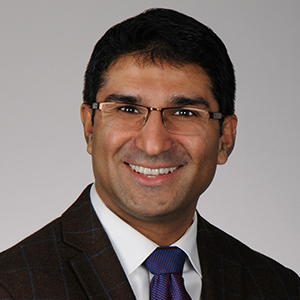Experimental Strategies in Organ Transplantation with Satish Nadig, MD, PhD
In response to the first successful animal heart transplant into a human patient, internationally renowned transplant surgeon Satish Nadig, MD, PhD, reviews some of the scientific developments that have culminated in this moment and stresses the ongoing need for other experimental strategies. Nadig is also the new director of Feinberg's Comprehensive Transplant Center.
Recorded Jan. 24, 2022

"We're on the cusp of the next era of transplant. We're really living history right now. I think this next decade is going to be the next resurgence or renaissance for transplantation and transplant immunology and science."
- Director of the Northwestern Medicine Comprehensive Transplant Center
- Chief of Organ Transplantation in the Department of Surgery
- Edward G. Elcock Professor of Surgical Research
- Professor of Surgery (Organ Transplantation), Microbiology-Immunology and Pediatrics
Episode Notes
-
Transplant surgery is a young field, with most developments occuring within the last five decades, Nadig explains. There are many limitations. The standard of care relies on the availability of donated organs and the use of antirejection medication, which suppresses the entire immune system.
-
Nadig's lab has been investigating pre-treatment strategies to condition organs prior to transplantation, thereby reducing the need for antirejection medication. To reach the organ, Nadig developed and patented a nanoparticle that delivers a fraction of antirejection medication to targeted cell subtypes.
-
Using gene-editing technology on a pig heart, surgeons at the University of Maryland performed a successful xenotransplantation, when an organ from an animal species is used in a human. Nadig comments on research and ethical implications of this breakthrough, as well as the history of xenotransplantation.
-
In his new role as director of the Comprehensive Transplant Center, Nadig aims to change the paradigm of how transplant medicine is practiced, increasing access to surgery for marginalized groups, for instance, through the Northwestern Medicine African American Transplant Access Program and Hispanic Transplant Program.
- Nadig says Northwestern has the largest number of patients off antirejection medications because of the tolerance-induction clinical trials his partner, Joseph Leventhal, MD, PhD, has been leading.
- With organs for transplant in such high demand, Nadig urges everyone to consider organ donation, calling donors the "true heroes."
Additional Reading:
- Nadig's paper in Transplantation, "Impact of Mitochondrial Permeability on Endothelial Cell Immunogenicity in Transplantation"
- Paper in Science Translational Medicine by Joseph Leventhal, MD, PhD, "Chimerism and Tolerance Without GVHD or Engraftment Syndrome in HLA-Mismatched Combined Kidney and Hematopoietic Stem Cell Transplantation"
- Release: University of Maryland surgeons perform first pig heart transplant into adult human
- "A brief history of cross-species organ transplantation"
